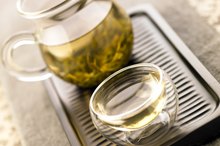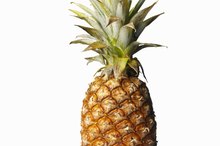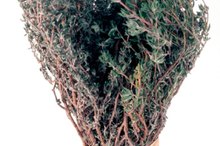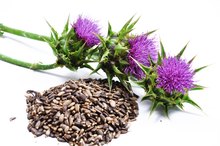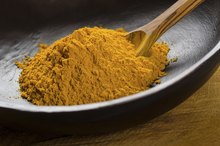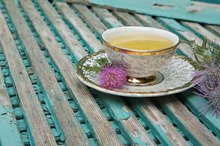Foods Containing Silymarin
Silymarin is a flavanoid and part of the phytonutrient family, which is a group of compounds found in plants that display antioxidant properties. Silymarin actually consists of three strong antioxidant chemicals called silybin, silidianin and silicristin. Silymarin is most concentrated in the milk thistle plant, where it's extracted from, but it can also be found in some common foods in much smaller amounts. Silymarin is generally considered safe and not toxic if consumed in foods, herbs and spices, but consult with your doctor before taking concentrated extracts of silymarin.
If you are experiencing serious medical symptoms, seek emergency treatment immediately.
Properties of Silymarin
Silymarin, also called Flavobion or Legalon, is a powerful antioxidant that seems to benefit your liver the most. According to the “Natural Standard Herb & Supplement Reference: Evidence-based Clinical Reviews,” animal studies have shown that silymarin helps repair damaged liver tissue, balances liver enzymes, enhances liver function and has a protective affect on the liver by preventing toxins from penetrating hepatic cell membranes 1. As such, silymarin is marketed in some countries, particularly the Philippines under the name Liveraide, as an herbal liver supplement. Anecdotal claims suggest that it may help people with some liver diseases, although it is unlikely to be helpful with advanced liver cirrhosis or cancer. Silymarin has also been identified as a potential cancer preventative, especially skin and colon cancers, but more research is required to better understand the mechanisms.
- Silymarin, also called Flavobion or Legalon, is a powerful antioxidant that seems to benefit your liver the most.
- Silymarin has also been identified as a potential cancer preventative, especially skin and colon cancers, but more research is required to better understand the mechanisms.
Milk Thistle
Dandelion vs. Milk Thistle
Learn More
Milk thistle, or Silybum marianum, is the richest source of silymarin. In fact, silymarin is often called milk thistle extract because its seeds contain about 70 percent of the phytonutrient according to the “Encyclopedia of Natural Medicine." Other parts of the milk thistle plant, such as the sprouts and stems, also contain silymarin, but the seeds are the most concentrated form 2. Milk thistle is indigenous to countries bordering the Mediterranean, where it is still thought of as a medicinal plant. In North America, milk thistle is often regarded as a weed and a target of pesticides. Silymarin is found in most plants of the thistle family.
- Milk thistle, or Silybum marianum, is the richest source of silymarin.
- Other parts of the milk thistle plant, such as the sprouts and stems, also contain silymarin, but the seeds are the most concentrated form 2.
Wild Artichokes
Wild artichokes are members of the thistle family and also contain decent amounts of silymarin. Silymarin accounts for the antioxidant behavior of artichokes and explains why it is food that can protect against the harmful effects of free radicals. Jerusalem artichokes do not contain silymarin because they are not members of the thistle family, despite their suggestive name.
Other Foods
Ashwagandha Liver Side Effects Contraindications
Learn More
Turmeric root and coriander seeds and leaves also contain silymarin. Turmeric is often ground into a yellow powder and used as a spice in curry dishes. Coriander leaves, also called cilantro, are a common additive in Thai and Mexican dishes. According to “Medical Herbalism” by David Hoffman, other foods that contain trace amounts of silymarin include:
- dark-skinned grapes
- beet greens
- black cohosh
- peanuts
- brewer's yeast
- most berries
Silymarin can also be consumed directly as an extract derived from milk thistle seeds.
- Turmeric root and coriander seeds and leaves also contain silymarin.
- Coriander leaves, also called cilantro, are a common additive in Thai and Mexican dishes.
Related Articles
References
- “Natural Standard Herb & Supplement Reference: Evidence-based Clinical Reviews”; Catherine E. Ulbricht et al; 2005
- “Encyclopedia of Natural Medicine”; M. Murray and J. Pizzorno; 2008
- “Medical Herbalism: The Science Principles and Practices of Herbal Medicine”; David Hoffman; 2003
- National Center for Complementary and Integrative Health. Milk Thistle. Updated September 2016.
- Abenavoli L, Capasso R, Milic N, Capasso F. Milk thistle in liver diseases: past, present, future. Phytother Res. 2010;24(10):1423-32. doi:10.1002/ptr.3207
- Salmi HA, Sarna S. Effect of silymarin on chemical, functional, and morphological alterations of the liver. A double-blind controlled study. Scand J Gastroenterol. 1982;17(4):517-21. doi:10.3109/00365528209182242
- Seeff LB, Curto TM, Szabo G, et al. Herbal product use by persons enrolled in the hepatitis C Antiviral Long-Term Treatment Against Cirrhosis (HALT-C) Trial. Hepatology. 2008;47(2):605-12. doi:10.1002/hep.22044
- Fried MW, Navarro VJ, Afdhal N, et al. Effect of silymarin (milk thistle) on liver disease in patients with chronic hepatitis C unsuccessfully treated with interferon therapy: a randomized controlled trial. JAMA. 2012;308(3):274-82. doi:10.1001/jama.2012.8265
- Ebrahimpour koujan S, Gargari BP, Mobasseri M, Valizadeh H, Asghari-jafarabadi M. Effects of Silybum marianum (L.) Gaertn. (silymarin) extract supplementation on antioxidant status and hs-CRP in patients with type 2 diabetes mellitus: a randomized, triple-blind, placebo-controlled clinical trial. Phytomedicine. 2015;22(2):290-6. doi:10.1016/j.phymed.2014.12.010
- Kazazis CE, Evangelopoulos AA, Kollas A, Vallianou NG. The therapeutic potential of milk thistle in diabetes. Rev Diabet Stud. 2014;11(2):167-74. doi:10.1900/RDS.2014.11.167
- Ebrahimpour, K.; Gargari, B.; Mobasseri, M. et al. Effects of Silybum marianum (L.) Gaertn. (silymarin) extract supplementation on antioxidant status and hs-CRP in patients with type 2 diabetes mellitus: a randomized, triple-blind, placebo-controlled clinical trial. Phytomedicine. 2015 Feb 15;22(2):290-6. DOI: 10.1016/j.phymed.2014.12.010.
- Fried, M.; Navarro, V.; Afdhal, N. et al. Effect of silymarin (milk thistle) on liver disease in patients with chronic hepatitis C unsuccessfully treated with interferon therapy: a randomized controlled trial. JAMA. 2012 Jul 18;308(3):274-82. DOI: 10.1001/jama.2012.8265.
- Rambaldi, A.; Jacobs, B.; Iaquinto G, Gluud C. Milk thistle for alcoholic and/or hepatitis B or C liver diseases--a systematic Cochrane hepato-biliary group review with meta-analyses of randomized clinical trials. Am J Gastroenterol. 2005 Nov;100(11):2583-91. DOI: 10.1111/j.1572-0241.2005.00262.x.
- Salmi, H. and Sarna, S. Effect of silymarin on chemical, functional, and morphological alterations of the liver. A double-blind controlled study. Scan J Gastroenterol. 1982;17:517–21.
- Seeff, L.; Curto, T.; Szabo, G. et al. Herbal product use by persons enrolled in the Hepatitis C Antiviral Long-Term Treatment Against Cirrhosis (HALT-C) Trial. Hepatology. 2008;47(2):605-12. DOI: 10.1002/hep.22044.
- Voroneanu, L.; Nistor, I.; Dumea, R. et al. Silymarin in Type 2 Diabetes Mellitus: A Systematic Review and Meta-Analysis of Randomized Controlled Trials. J Diabetes Res. 2016;2016:5147468. DOI: 10.1155/2016/5147468.
Writer Bio
Sirah Dubois is currently a PhD student in food science after having completed her master's degree in nutrition at the University of Alberta. She has worked in private practice as a dietitian in Edmonton, Canada and her nutrition-related articles have appeared in The Edmonton Journal newspaper.


